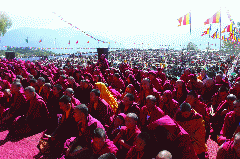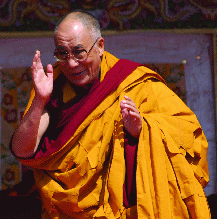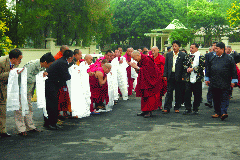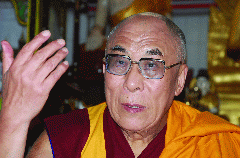The Dalai Lama A divinity amidst us
The Dalai Lama A divinity amidst us
Recipient of the Nobel Peace Prize His Holiness the 14th Dalai Lama revered by not only his devotees spread all over the world, is also hugely respected by the international community-for espousing the message of ‘Peace and Compassion’ all over the globe. His Holiness was recently on a weeklong tour to the majestic Himalayan State of Arunachal Pradesh. The Dalai Lama brushed off Chinese protests and traveled to this remote Himalayan town of Tawang near the Tibetan border to lead five days of prayers and teaching sessions. His Holiness’ visit to the state has sent a clear message to the Land of the Dragon (China) that Arunachal Pradesh is an integral part of India where the people even today greet one another with ‘Jai Hind’. During His Holiness’ weeklong tour, the first leg of his visit was to Tawang where he stayed for four days and inaugurated the District Hospital funded by him. He then boarded a flight to Itanagar before finally leaving through Delhi for Rome.
respected by the international community-for espousing the message of ‘Peace and Compassion’ all over the globe. His Holiness was recently on a weeklong tour to the majestic Himalayan State of Arunachal Pradesh. The Dalai Lama brushed off Chinese protests and traveled to this remote Himalayan town of Tawang near the Tibetan border to lead five days of prayers and teaching sessions. His Holiness’ visit to the state has sent a clear message to the Land of the Dragon (China) that Arunachal Pradesh is an integral part of India where the people even today greet one another with ‘Jai Hind’. During His Holiness’ weeklong tour, the first leg of his visit was to Tawang where he stayed for four days and inaugurated the District Hospital funded by him. He then boarded a flight to Itanagar before finally leaving through Delhi for Rome.
The Faith that sustains
The staccato beats of propellers pierced the quiet, misty mountains of Tawang the remote Buddhist enclave nestled in the icy folds of the eastern Himalayas to send the devout Buddhist people to an unusual eruption of joy as thousands of Buddhist monks and supporters accorded a majestic welcome to His Holiness along with his ten member entourage who arrived on the first leg of the weeklong visit to Arunachal Pradesh and many could not hold back tears at the sight of the Dalai Lama.
To welcome the spiritual leader, people from all walks of life got together to deck up the town to its best. Roads were washed, welcome gates with colourful Buddhist paintings erected and the valley’s main monastery was decked up. For the first time in Arunachal Pradesh the presence of the national press was represented by more than 200 journalists belonging to both print and electronic media besides correspondents of the foreign media, not withstanding the ban on their entry by New Delhi were at the scene to cover the visit of the Tibetan leader Dalai Lama.
 On the eve of His Holiness’ arrival, thousands of people carrying khatas, flowers and incense sticks thronged both sides of road leading to the Tawang Monastery to catch a glimpse of the revered Lama. Lamas or monks swathed in maroon and saffron robes chanted sutras and swung incense sticks before a 25-ft high golden Buddha at the main monastery - a pagoda-like structure with brilliant red, blue and white paintings.
On the eve of His Holiness’ arrival, thousands of people carrying khatas, flowers and incense sticks thronged both sides of road leading to the Tawang Monastery to catch a glimpse of the revered Lama. Lamas or monks swathed in maroon and saffron robes chanted sutras and swung incense sticks before a 25-ft high golden Buddha at the main monastery - a pagoda-like structure with brilliant red, blue and white paintings.
The joy of the people knew no bounds as on being interviewed by a shutterbug, a young woman who stated that her name was Choeden, in between helping to put up Tibetan scripture-bearing holy flags said “He is our god, he has come back to bless us all. China may or may not recognize him but that is not important for us. Can the Chinese remove him from our hearts?” Pema Tsering, who runs a local grocery store, also speaking to the reporter, said “They call him names to belittle him. But he is like the ocean, a few drops of poison doesn’t spoil it.”
Beijing calls the Dalai Lama a dangerous “splittist” plotting Tibetan independence, a charge His Holiness denies. He says he is merely seeking autonomy for Tibet. The Tibetan spiritual leader, defending his visit to Tawang in Arunachal Pradesh said that he wasn’t surprised by Beijing’s reaction as his visit to this part was non-political. Though the visit has been embroiled in controversies, nothing could deter the infectious enthusiasm of the devotees as for them, what mattered most was catching a glimpse of the living God, who is the very core of their existence.
Despite the restrictions imposed in Arunachal Pradesh, the Dalai Lama continued to draw thousands of followers. From the very first day of his arrival till the fourth day, Tawang remained closed for about six hours as almost all its residents attended the Tibetan leader’s discourse at the Yid-Gha-Choezin Monastery. Despite the chilly weather, unprecedented enthusiasm and joy was seen along the 186-km stretch from Tawang to Bomdi La, the route the Dalai Lama had taken during his sensational flight from Tibet in 1959. Local Buddhists draped the road with thousands of five-colour religious flags and welcome arches with sacred motifs erected at numerous places. The followers of the Dalai Lama were seen going to Dirang and Bomdi La to listen to his discourses over the next two days. “We are all thrilled to find god’s reincarnation among us,” said Pema Thondup, a former Assam Rifles jawan from Themang, as he walked to the venue of the Dalai Lama’s discourse at Dirang.
During his last few days of his stay at the Last Shangri-La of Aruanchal Pradesh, His Holiness visited various monasteries where he delivered religious discourses, inaugurated a Monastery Museum, a Monastery School Library, the District hospital funded by him besides laying the foundation stone of Jibkyob Thongdrol Chorten near Urgelling, the birth place of the 6th Dali Lama Gyalma Rinchen Tsayang Gyatso. He also planted a sapling at Yid Gha Choezin (Gompa) and distributed 1500 blessed saplings to the local people, calling on them to protect the environment of the Himalayas which will reduce the impact of global warming.
religious discourses, inaugurated a Monastery Museum, a Monastery School Library, the District hospital funded by him besides laying the foundation stone of Jibkyob Thongdrol Chorten near Urgelling, the birth place of the 6th Dali Lama Gyalma Rinchen Tsayang Gyatso. He also planted a sapling at Yid Gha Choezin (Gompa) and distributed 1500 blessed saplings to the local people, calling on them to protect the environment of the Himalayas which will reduce the impact of global warming.
The Spiritual Leader with a renewed hope and cherished memories flew back to Itanagar where thousands of devotes waited eagerly to get a glimpse of him.
Town Joyfully Greets Dalai Lama
-
Town Joyfully Greets Dalai Lama
Town Joyfully Greets Dalai Lama
During his short stay at the state capital, His Holiness visited Thupten Gatsalling Gonpa, Theravada Buddhist Monastary, Banquet Hall and the newly constructed Chief Minister’s residence where he halted for a night before his departure through New Delhi to Rome. On his visit to these monasteries His Holiness mesmerized thousands of people with his divine oratory skill. Speaking to the people and devotes on wide ranging issues afflicting the society, His Holiness the Dalai Lama prescribed introspection as the only mantra for positive changes. They listened in rapt attention as the Dalai Lama preached on teachings of Lord Buddha. The only commotion was the laughter that the Dalai Lama evoked with his usual humour. He covered issues ranging from environment protection to corruption and the need of balancing modern with traditional values. He said that millions of people had lost their lives through violence and that the economy of many countries got ruined due to conflicts in the 20th century. “Let the 21st century be a century of tolerance and dialogue.”
 Responding to a question on what is the relation between insaan and bhagwaan (Human and God) and how to recognize it, His Holiness said that the Buddhist philosophy believes in rebirth but not in the concept of a creator. The soul being immortal is the proof of the supernatural power and advised the correspondent not to ask what his relation with god is if he happens to meet him. A warm and rousing traditional reception was accorded to His Holiness when he arrived at the Theravada Buddhist Monastery of the Theravada (Hinayana) sect where he blessed the gathering, read some phrases of Lord Buddha’s teaching and conducted a prayer for the overall peace of the world. Before finally departing to New Delhi, the next day at his breakfast His Holiness also had the delight of tasting the mouth watering dishes like Khao-lam with honey (bamboo rice), khao-tom (steamed rice), khao-puk (fried rice cakes) of the Tai Khampti of Theravada Buddhist Society.
Responding to a question on what is the relation between insaan and bhagwaan (Human and God) and how to recognize it, His Holiness said that the Buddhist philosophy believes in rebirth but not in the concept of a creator. The soul being immortal is the proof of the supernatural power and advised the correspondent not to ask what his relation with god is if he happens to meet him. A warm and rousing traditional reception was accorded to His Holiness when he arrived at the Theravada Buddhist Monastery of the Theravada (Hinayana) sect where he blessed the gathering, read some phrases of Lord Buddha’s teaching and conducted a prayer for the overall peace of the world. Before finally departing to New Delhi, the next day at his breakfast His Holiness also had the delight of tasting the mouth watering dishes like Khao-lam with honey (bamboo rice), khao-tom (steamed rice), khao-puk (fried rice cakes) of the Tai Khampti of Theravada Buddhist Society.
A tearful adieu
Yet again, the staccato beats of propellers pierced the quiet, misty mountains of Itanagar as a Pawan Hans chopper switched on its rotor blades and took off from the Raj Bhavan helipad. The chopper took along with it all the heavenly bliss and jubilation that people of Arunachal Pradesh had managed to gather through the week. Chief Minister Dorjee Khandu, his Cabinet colleagues as well as many MLAs escorted the Dalai Lama to the Raj Bhavan helipad as he completed the last leg of his visit to the frontier state amid China’s stiff opposition. The Dalai Lama’s departure silenced wagging tongues, not to mention the gibes that New Delhi and Beijing exchanged before and throughout the spiritual leader’s visit. But for Arunachal Pradesh, it was different. Much removed from the political mudslinging, the simple folk of the country’s easternmost state bid a tearful farewell to their ‘God’ assembling in hordes near the helipad to catch a last glimpse and seek the spiritual leader’s final blessings before the chopper disappeared beyond the horizon. As the followers gloomily trooped back to their homes, a gnawing fear that the Tibetan spiritual leader may not come back slowed their strides and moistened their eyes. The Dalai Lama’s advancing age and busy schedule; he will fly down to Rome from Delhi to inaugurate the two-day Fifth World Parliamentary Convention beginning from November 18; further rooted this grim possibility in their sorrowed hearts. Om Mani Padme Hum
Chow Bilaseng Namchoom


